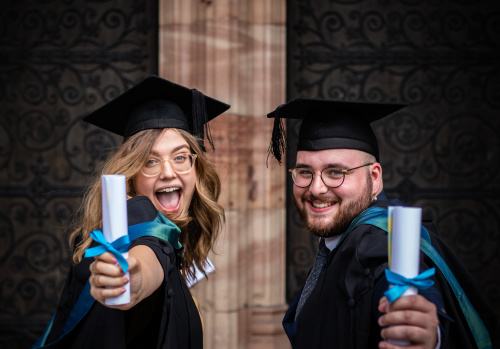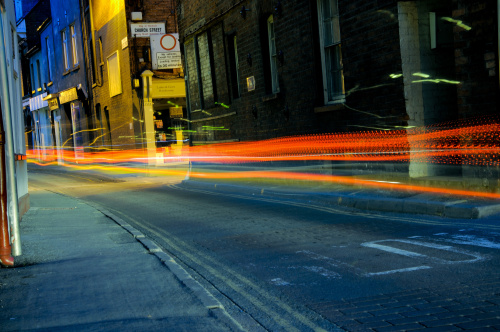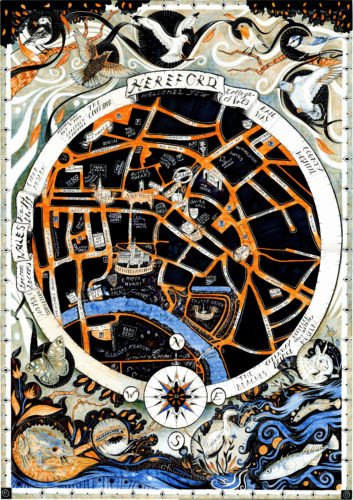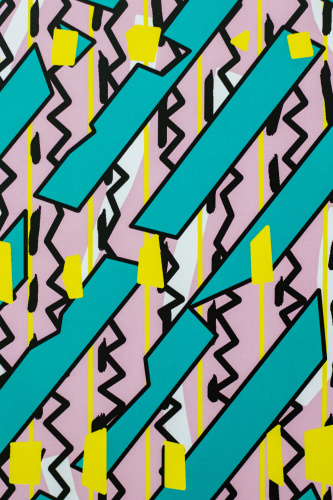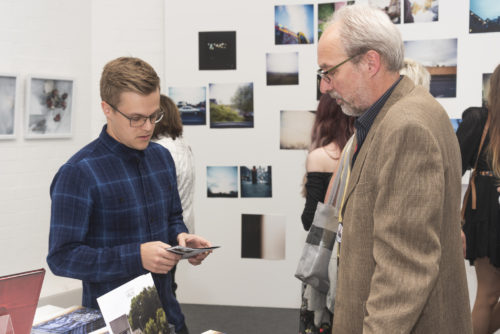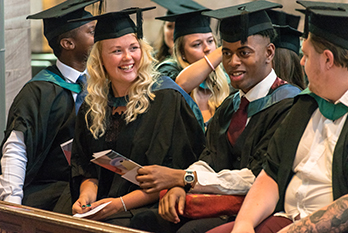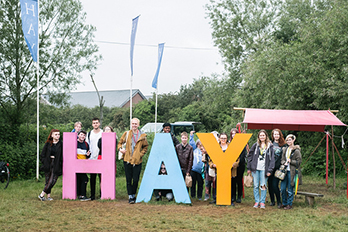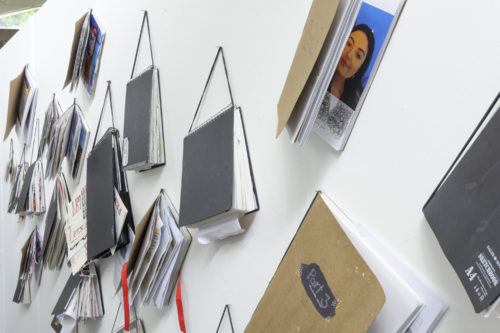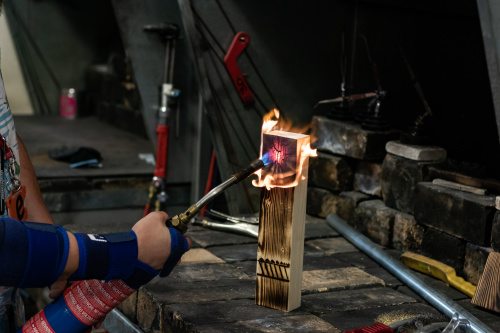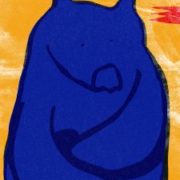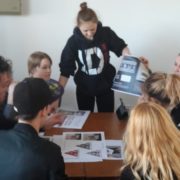HCA at Hay 2012: Learning space, learning place
Published on 16.06.17
Hereford College of Arts has a strong relationship with Hay Festival which manifests differently in each yearly iteration, and always add to the richness of our students experience. From a scholarship perspective, last year I looked at Hay Festival regarding its relationship to ideas of ‘partnership learning communities’ and students learning valuable employability skills through
Categories
Hereford College of Arts has a strong relationship with Hay Festival which manifests differently in each yearly iteration, and always add to the richness of our students experience.[1] From a scholarship perspective, last year I looked at Hay Festival regarding its relationship to ideas of ‘partnership learning communities’ and students learning valuable employability skills through running workshops.
This year, informed by a year of interesting conversations which culminated with remote participation in #Porousuni and #melsig thanks to the amazing virtually connecting team, I want to think about Hay regarding learning space and learning place.
We know Hay is an incredible learning opportunity for our students, but this isn’t simply because of the access it affords to a vast and dizzying range of high-profile events. The richness of the experience here is more complex. There is something in the geography and physical experience of Hay which seems to create learning opportunities that evolve around the unfinished conversation – the meeting that is waiting to happen. These half-glimpsed and unresolved moments of contact with worlds which are, by their very nature, different (urban and rural, formal broadcast and live pop-up show) seem to open up pathways or potential routes to many different, surprising and yet entirely possible outcomes.
Again, this is more than the fact that you might bump into a well-known media figure or author in a ‘live’ situation. This is, perhaps, part of a conversation informed by the particular learning space Hay offers. The festival is made up of many different sized learning spaces – from formal lectures through to intimate conversations, to pop-up live performances, to cafe culture and social learning spaces. Some of these places are ‘big-name’ lectures; others are friendly pop-up events that let nervous students interview accessible and interested authors, spaces constructed from a friendly, empathetic and kind perspective which are created to share ideas and invite conversation. Egalitarian spaces.


Big or small, formal and informal, this literary festival brims with a multiplicity of opportunities to learn. But this isn’t the focus of this post. Hay is unafraid of creating a plethora of unassigned space. Between tents and walkways, cafes and ‘public social spaces’ there are grassy pockets where people can sit, read or chat. Such spaces invite the individual as well as small group. And, at the centre of Hay, there is a common land – rather like a library in a field, a place to picnic and wait and talk.A semi-structured space where ideas drift across site from the more formal tents and discussion tents.
Learning place, for me, is a different idea to learning space. Place is all about the individual in their contexts – this can be where we physically ‘are,’ our social ‘place,’ our opportunities and our reflexive positioning within ideas. It is a process as well as a concept.
Learning space, again from my perspective, is all about creation and potential. One meaning of space is ‘lacuna’ or ‘gap’- for me, our ‘learning space’ would be the unfinished conversation – the half-formed thought and object that is unfixed and developing. It is all about where we could go, not where we are.
I would argue that Hay creates gaps, pathways across ideas, pathways across social worlds. Pathways across ‘place.’ The geography of Hay creates gaps in the spaces between events, tents, cafes. And in these gaps, people have space to converse, reflect and observe as pauses between events or migrations to social spaces.
John Stuart Mill, on ‘Liberty’ quotes Von Humbolt:
“there are two requisites, “freedom, and a variety of situations;” and that from the union of these arise “individual vigour and manifold diversity,” which combine themselves in “originality.”
If there was a recipe for originality, Hay might be it. Hay’s gaps, pathways, and places together create a space where the individual is free to engage in thought without being wary of going against some common cultural path. Perhaps this is due to the surrounding landscape, with its history of seasonal migrations to and from the city or perhaps because this is not an unfettered or untended space; even in its public spaces, Hay is quiet, humming with a murmur and a flutter of flags, a place of sharing conversation rather than declaiming. Hay is organised – by and with small armies of volunteers and hard-working staff. It is home to the most immaculate festival toilets I have ever experienced.
Children play freely, and I am not at all suggesting that the atmosphere is one of repression, but rather that play takes place in an atmosphere of gentle free-fall. If you like, this is a very rural rebellion, a counter-argument to the ‘lack, lag and rosy past’ framing of rural learning spaces and re-inventing them as a co-operative, essentially social place where different ideas can meet and be discussed.[2]
And Hay moves. If you sit and look across a central area of chairs and flags, you can see movement, and see pathways – to the next group of people, to a tea tent, to a lecture or Radio 3 broadcast. People are walking, the wind creates noise, and in that look across a ‘free space’, you might spot a literary celebrity or a student or a family. The very geography and nature of place work to create a meta-awareness of an idea of ‘safe change.’ Change as potential flourish, rather than a threat. There is space for imagination. Movement and space create these glimpses of multiple pathways across to different worlds and let you choose whether you wish to follow them.
If we accept that our current world is both epistemologically and ontologically fragile – how can we be sure our constructed ‘truths’ are valid – then perhaps this kind of unassigned learning place – the ‘green learning’ of Hay offers an antidote in offering up fragile safe spaces to reflect in, boundaried with more formal talks where ideologies and discussions are shared and ideas spread through conversation like the floating seeds of dandelions, mapping and falling to grow across boundaries in a kind of achenesis which is at home in both rural and urban landscapes.
When we talk about ‘social mobility’ or ‘social capital’ we often use these phrases as something that might be ‘done’ to a social group; just as when we talk about ‘empowering’ or ‘engaging’ students there are inherent power assumptions in our language. However well-meaning, there is at heart a corporate power – a control which doesn’t always enable a genuine free-flow of ideas. A power which, despite perhaps having intentions to the contrary, will ‘weed’ based on dominant classifications of ideas.
I would argue that Hay is as free from this as from the sophistries of architecture which is designed to encourage informal learning, and, in doing so, formalises. There is a rhizomatic quality to Hay, but the particular place and space the festival inhabits create a kind of ‘green field’ learning; learning which enables individual thought and action[3] through reflection and discussion. Learning which lets pathways be imagined, mapped and created. This learning is not messy – but it is learning which allows the gaps between formality to flourish and for ideas to free-float, land and grow
[1] This year we ran letterpress workshops, provided vinyls for the site, hosted multiple activities in the ‘Make and Take’ tent, performed in collaboration with authors, participated in Radio 3’s ‘The Verb’, ran animation workshops with Mash Cinema and ended the week by shipping a bus-load of students off for a ‘Hay away-day’. I may have missed something out. Animation students created idents which were shown widely to Hay audiences on venue showreels, CDC students created interactive sculptural pieces exhibited onsite ( Libby Vale and Tilly Gomershall ) and PA BA students worked collaboratively with Andrew Graham (illustration BA hons ) along with writer Nicola Davies and Open Sky theatre group to produce Hay commissioned 3,000 CHAIRS show
[2] In a recent email discussion with colleague Aine Venables (who moved from HCA recently to become a permanent member of the Hay Festival team) we both highlighted how Hay’s influence has supported our students to create their own learning pathways.
[3] I would argue that participation in Hay inspired our graduates to produce some truly extraordinary work – work which encourages direct participative action from visitors and presents potential solutions to real-life complex problems.
Huge thanks to Aine for providing detail of HCA’s participation in Hay30 for this post
